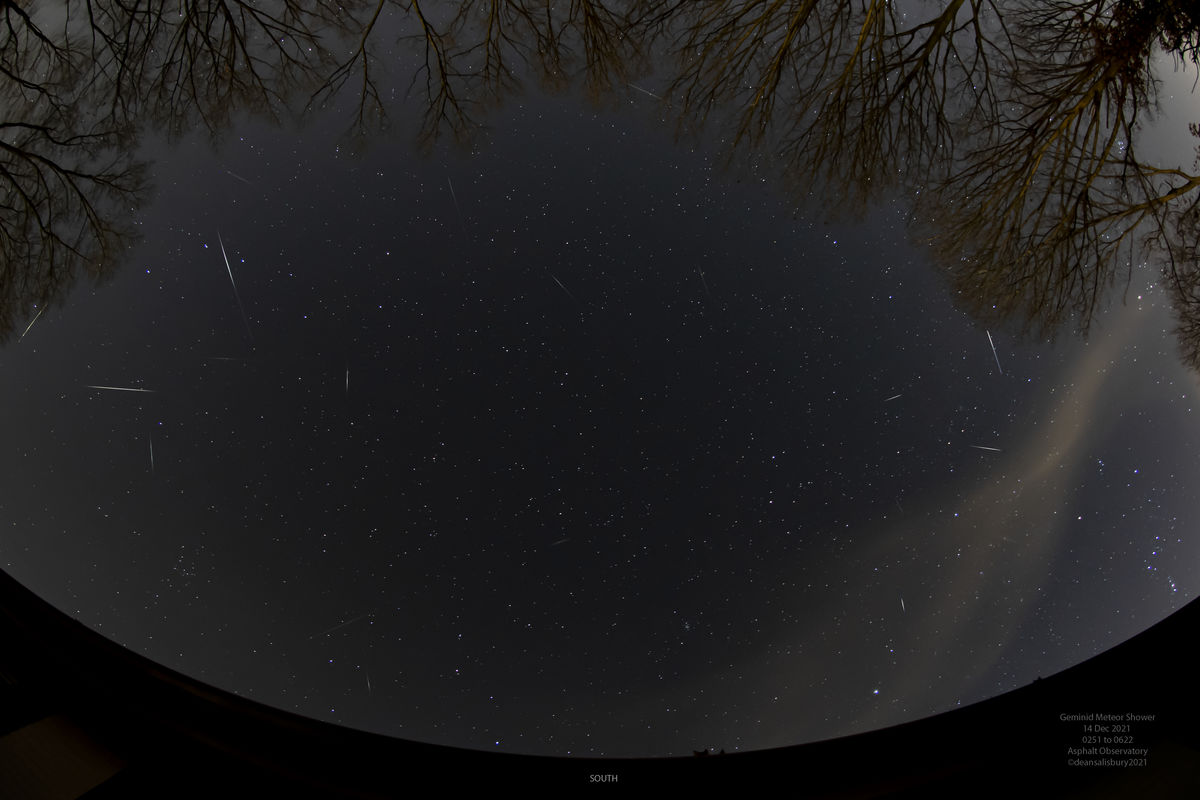2021 Geminid Meteor shower
Dec 15, 2021 09:29:37 #
Sharing my image of the 14 December Geminid Meteor shower.
I attached a Nikon 10.5mm f2/8 DX Fisheye lens on a tripod mounted Nikon D500 DX camera body and pointed it straight up. Then wrapped a chemical hand warmer around the lens, securing it with a rubber band to keep dew from condensing on the front objective. The built in interval timer was set up to make 300 images, each a 30 second exposure with a 30 second interval between exposures. The 70% Moon would not set until just after 3am. The timer was set to start imaging at 2am to provide an opportunity for adjustments prior to moonset.
The sky was pretty bright at 2am, the moon was decending toward the western horizon but was reflecting a bunch of light on a low level thin layer of fast moving clouds. Stars were visible through the clouds and there were areas of clear sky teasing me to proceed. A few test images determined that the best exposure under these conditions would be f/4.4 at ISO 1100. I hit the “go” button and went back to bed.
From 297 images I was able to find 19 that had meteors. Most were faint but there were some fireballs. The intermittent clouds impacted intensity.
This is a composite image of the 19 meteors. Orion is visible in the lower right corner, the Big Dipper left of center about a third of the way from the top. Gemini (the radiant point) is just right of center about two thirds from the top. The two bright vertically aligned stars are Castor and Pollux, the Gemini twins.
I attached a Nikon 10.5mm f2/8 DX Fisheye lens on a tripod mounted Nikon D500 DX camera body and pointed it straight up. Then wrapped a chemical hand warmer around the lens, securing it with a rubber band to keep dew from condensing on the front objective. The built in interval timer was set up to make 300 images, each a 30 second exposure with a 30 second interval between exposures. The 70% Moon would not set until just after 3am. The timer was set to start imaging at 2am to provide an opportunity for adjustments prior to moonset.
The sky was pretty bright at 2am, the moon was decending toward the western horizon but was reflecting a bunch of light on a low level thin layer of fast moving clouds. Stars were visible through the clouds and there were areas of clear sky teasing me to proceed. A few test images determined that the best exposure under these conditions would be f/4.4 at ISO 1100. I hit the “go” button and went back to bed.
From 297 images I was able to find 19 that had meteors. Most were faint but there were some fireballs. The intermittent clouds impacted intensity.
This is a composite image of the 19 meteors. Orion is visible in the lower right corner, the Big Dipper left of center about a third of the way from the top. Gemini (the radiant point) is just right of center about two thirds from the top. The two bright vertically aligned stars are Castor and Pollux, the Gemini twins.
Dec 15, 2021 09:45:39 #
7awol wrote:
Sharing my image of the 14 December Geminid Meteor... (show quote)
Very impressive. Total cloud cover here in the UK
Dec 15, 2021 14:51:18 #
Dec 16, 2021 06:07:23 #
Marc G wrote:
Very impressive. Total cloud cover here in the UK
1hr. to midday and you could bounce a searchlight off the cloud here. NO chance of seeing those here this year.
Static high forecast to hang around for a while.
Dec 17, 2021 09:05:15 #
Dec 18, 2021 14:51:40 #
Ballard
Loc: Grass Valley, California
7awol wrote:
Sharing my image of the 14 December Geminid Meteor... (show quote)
Really nice composite fisheye image. Great work.
If you want to reply, then register here. Registration is free and your account is created instantly, so you can post right away.





